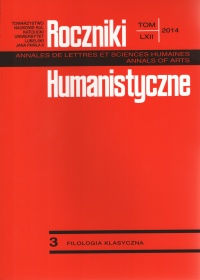Types of Latin Evaluative Adverbs
Abstract
The article suggests ordering the division of the sub-group of sentential adverbs, defined as evaluative adverbs, that is not consistent enough. The suggestion consists first of all in separating evaluative adverbs in the strict sense, that is ones referring to axiological categories, from other types of evaluative adverbs. Among the latter the following ones may be distinguished: 1. Epistemic adverbs, with the help of which the speaker evaluates the truth of the proposition (certe, certo, plane, profecto, sane, vero, vere, fortasse, forsitan), 2. evidential adverbs that point the basis on which the speaker gives some information (scilicet, videlicet), and 3. mirative adverbs, with which the speaker expresses his surprise that the given state of affairs does occur (inopinanter, inopinate, inopinato, necopinato). Among 4.the evaluative adverbs in the strict sense, in turn, four sub-groups may be distinguished: a. generally evaluating (bene, male), b. referring to cognitive values (sapientier, stulte, imprudenter, inepte, recte, falso), c. referring to utilitarian values (opportune, feliciter, (per)commode incommode, perincommode), and d. referring to moral values (recte, falso, merito, iure, iniuria). In the suggestion, recognizing the adverbs expressing surprise as the marker of mirativity is the most arguable point, as it is a language category that has been noticed relatively recently and has not been yet well recognized.
References
Aikhenvald A.Y.: Evidentiality, Oxford: Oxford University Press 2004.
Bellert I.: On Semantic and Distributional Properties of Sentential Adverbs, „Linguistic Inquiry” 8 (1977), s. 337-351.
De Haan F.: Evidentiality and Epistemic Modality: Setting Boundaries, „Southwest Journal of Linguistics” 18/1 (1999), s. 83-101.
DeLancey S.: Mirativity: The Grammatical Marking of Unexpected Information, „Linguistic Typology” 1/1 (1997), s. 33-52.
DeLancey S.: The Mirative and Evidentiality, „Journal of Pragmatics” 33 (2001), s. 369-382.
DeLancey S.: Still Mirative after All These Years, „Linguistic Typology” 16/3 (2012), s.529-564.
Dendale P., Tasmowski L.: Introduction: Evidentiality and Related Notions, „Journal of Pragmatics” 33/3 (2001), s. 339-348.
Dik S.C.: The Theory of Functional Grammar, Berlin/New York: Mouton de Gruyter 1997.
Górska M.: Łaciński leksem „sane” jako tzw. wyrażenie funkcyjne, „Roczniki Humanistyczne” 57 (2009), z. 6, s. 11-27.
Grzegorczykowa R.: Funkcje semantyczne i składniowe polskich przysłówków, Wrocław: Ossolineum 1975.
Kühner R., Stegmann C.: Ausführliche Grammatik der lateinischen Sprache I. Darmstadt: Wissenschaftliche Buchgesellschaft 1962.
Pinkster H.: On Latin Adverbs, Amsterdam: North-Holland Publishing Company 1972.
Pinkster H.: Latin Syntax and Semantics, London: Routledge 1990.
Pinkster H.: Attitudinal and Illocutionary Satellites in Latin, w: Words in Their Places, red. H. Aertsen, M. Hannay, R. J. Lyall, Amsterdam: Vrije Universiteit Amsterdam 2004, s. 191-198.
Puzynina J.: Język wartości, Warszawa: PWN 1992.
Puzynina J.: Problemy wartościowania w języku i tekście, „Etnolingwistyka” 16 (2004), s.179-189.
Ramat P., Ricca D.: Sentence Adverbs in the Languages of Europe, w: Adverbial Constructions in the Languages of Europe, red. J. van der Auwera, Berlin/New York: Mouton de Gruyter 1998, s. 187-275.
Ricca D.: Adverbs, w: New Perspectives on Historical Latin Syntax, Volume 2: Constituent Syntax: Adverbial Phrases, Adverbs, Mood, Tense, red. F. Baldi, P. Cuzzolin, Berlin–New York: Mouton de Gruyter 2010, s. 109-192.
Schrickx J.: Lateinische Modalpartikeln: nempe, quippe, scilicet, videlicet und nimirum, Leiden: Brill 2011.
Schrickx J.: Latin Commitment-markers: scilicet and videlicet, w: Certainty-uncertainty— and the Attitudinal Space in Between, red. S. Cantarini, W. Abraham, E. Leiss, Amsterdam–Philadelphia: John Benjamins Publishing Company 2014, s. 285-296.
Copyright (c) 2014 Roczniki Humanistyczne

This work is licensed under a Creative Commons Attribution-NonCommercial-NoDerivatives 4.0 International License.





